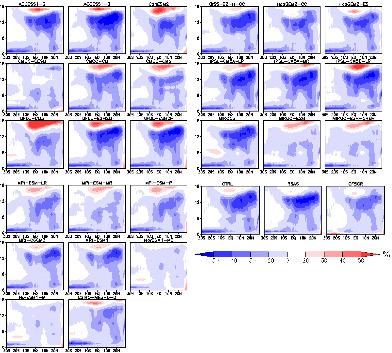当前位置:
X-MOL 学术
›
Q. J. R. Meteorol. Soc.
›
论文详情
Our official English website, www.x-mol.net, welcomes your
feedback! (Note: you will need to create a separate account there.)
Assessment of climate models in relation to the low‐level clouds over the southern Indian Ocean
Quarterly Journal of the Royal Meteorological Society ( IF 3.0 ) Pub Date : 2020-06-10 , DOI: 10.1002/qj.3847 Kumar Roy 1, 2 , P. Mukhopadhyay 1 , R. P. M. Krishna 1 , Malay Ganai 1 , M. Mahakur 1 , T. N. Rao 3 , Anish Kumar M. Nair 3, 4 , S. S. V. S. Ramakrishna 2
Quarterly Journal of the Royal Meteorological Society ( IF 3.0 ) Pub Date : 2020-06-10 , DOI: 10.1002/qj.3847 Kumar Roy 1, 2 , P. Mukhopadhyay 1 , R. P. M. Krishna 1 , Malay Ganai 1 , M. Mahakur 1 , T. N. Rao 3 , Anish Kumar M. Nair 3, 4 , S. S. V. S. Ramakrishna 2
Affiliation

|
Against the backdrop of limited fidelity of climate models in capturing low‐level cloud variability, the representation of the southern Indian Ocean (SIO) marine boundary layer (MBL) clouds and their transition from low to deep cloud have been investigated in this study. A historical run of 26 models, that featured in the Coupled Model Intercomparison Project Phase 5 (CMIP5), and the National Centers for Environmental Prediction (NCEP)'s Climate Forecast System version 2.0 (CFSv2) models have been analysed along with different observational and reanalysis products. Observations clearly show the prominent occurrence of MBL low‐level clouds over the SIO in a 30–10°S latitudinal and 80–100°E longitudinal belt. Furthermore, there is a gradual transition from low to deep cloud towards the north of the Equator. The results reveal that the CMIP5 models were hardly able to capture the MBL low‐level clouds due to inaccurate temperature inversion and lower‐tropospheric stability (LTS) simulations. As compared to observations, the CMIP5 models show limited fidelity in capturing the transition from low to deep cloud at the north of the Equator. In this study, evaluation of one version of the CFS in which the convective parameterization is changed to the revised simplified Arakawa–Schubert (RSAS) scheme is carried out. In another CFS version (CFSR) with a more physically based cloud scheme (WRF Single‐Moment 6‐Class microphysics scheme; WSM6), comparisons are made with the default CFSv2 (CTRL) and RSAS. Only very few models, such as the MPI‐ESM‐LR, MRI, HadGEM, and NorESM models from among the 26 CMIP5 suites, and CFSCR from among the CFS suites, showed some fidelity in capturing the low‐level clouds over the SIO. This highlights that significant improvement is needed in climate models to improve the representation of the MBL over the SIO.
中文翻译:

与印度洋南部低空云有关的气候模型评估
在捕获低层云变化的气候模型保真度有限的背景下,本研究对印度洋南部(SIO)海洋边界层(MBL)云的表示及其从低云到深云的过渡进行了研究。分析了26个模型的历史运行,这些模型在“耦合模型比较项目”第5阶段(CMIP5)和国家环境预测中心(NCEP)的气候预测系统2.0版(CFSv2)模型中进行了分析,并进行了不同的观测和分析。再分析产品。观测清楚地表明,在30–10°S纬度带和80–100°E纵向带中,SIO上方MBL低层云的突出发生。此外,从低云到深云向赤道北部逐渐过渡。结果表明,由于不准确的温度反演和低对流层稳定性(LTS)模拟,CMIP5模型几乎无法捕获MBL低层云。与观察结果相比,CMIP5模型在捕获赤道以北低云到深云的过渡过程中显示出有限的保真度。在这项研究中,对将对流参数化更改为修订的简化Arakawa–Schubert(RSAS)方案的CFS版本进行了评估。在具有更基于物理的云方案(WRF单矩6类微物理学方案; WSM6)的另一个CFS版本(CFSR)中,将使用默认的CFSv2(CTRL)和RSAS进行比较。在26个CMIP5套件中,只有极少数模型,例如MPI-ESM-LR,MRI,HadGEM和NorESM模型,以及CFS套件中的CFSCR,在捕获SIO上的底层云时表现出一定的忠诚度。这突出表明,气候模型需要进行重大改进,以改进MBL相对于SIO的表示。
更新日期:2020-06-10
中文翻译:

与印度洋南部低空云有关的气候模型评估
在捕获低层云变化的气候模型保真度有限的背景下,本研究对印度洋南部(SIO)海洋边界层(MBL)云的表示及其从低云到深云的过渡进行了研究。分析了26个模型的历史运行,这些模型在“耦合模型比较项目”第5阶段(CMIP5)和国家环境预测中心(NCEP)的气候预测系统2.0版(CFSv2)模型中进行了分析,并进行了不同的观测和分析。再分析产品。观测清楚地表明,在30–10°S纬度带和80–100°E纵向带中,SIO上方MBL低层云的突出发生。此外,从低云到深云向赤道北部逐渐过渡。结果表明,由于不准确的温度反演和低对流层稳定性(LTS)模拟,CMIP5模型几乎无法捕获MBL低层云。与观察结果相比,CMIP5模型在捕获赤道以北低云到深云的过渡过程中显示出有限的保真度。在这项研究中,对将对流参数化更改为修订的简化Arakawa–Schubert(RSAS)方案的CFS版本进行了评估。在具有更基于物理的云方案(WRF单矩6类微物理学方案; WSM6)的另一个CFS版本(CFSR)中,将使用默认的CFSv2(CTRL)和RSAS进行比较。在26个CMIP5套件中,只有极少数模型,例如MPI-ESM-LR,MRI,HadGEM和NorESM模型,以及CFS套件中的CFSCR,在捕获SIO上的底层云时表现出一定的忠诚度。这突出表明,气候模型需要进行重大改进,以改进MBL相对于SIO的表示。











































 京公网安备 11010802027423号
京公网安备 11010802027423号